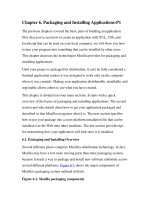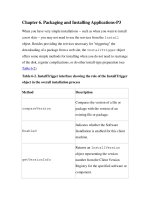Chapter 6 - VLSM and CIDR CCNA docx
Bạn đang xem bản rút gọn của tài liệu. Xem và tải ngay bản đầy đủ của tài liệu tại đây (904.56 KB, 34 trang )
Chapter 6 - VLSM and CIDR
CCNA Exploration version 4.0
Học viện mạng Bách Khoa - Website: www.bkacad.com 2
Objectives
• Compare and contrast classful and classless IP
addressing.
• Review VLSM and explain the benefits of classless IP
addressing.
• Describe the role of the Classless Inter-Domain
Routing (CIDR) standard in making efficient use of
scarce IPv4 addresses
Học viện mạng Bách Khoa - Website: www.bkacad.com 3
Introduction
• Prior to 1981, IP addresses used only the first 8 bits to
specify the network portion of the address
• In 1981, RFC 791 modified the IPv4 32-bit address to
allow for three different classes
• IP address space was depleting rapidly
– the Internet Engineering Task Force (IETF)
introduced Classless Inter-Domain Routing (CIDR)
– CIDR uses Variable Length Subnet Masking
(VLSM) to help conserve address space.
» -VLSM is simply subnetting a subnet
Học viện mạng Bách Khoa - Website: www.bkacad.com 4
Classful and Classless IP Addressing
• Classful IP addressing
• As of January 2007, there are over 433 million hosts on
internet
• Initiatives to conserve IPv4 address space include:
-VLSM & CIDR notation (1993, RFC 1519).
-Network Address Translation (1994, RFC 1631).
-Private Addressing (1996, RFC 1918).
Học viện mạng Bách Khoa - Website: www.bkacad.com 5
• The High Order Bits
These are the leftmost bits in a 32 bit address
Classful and Classless IP Addressing
Học viện mạng Bách Khoa - Website: www.bkacad.com 6
• Classes of IP addresses are identified by the decimal
number of the 1st octet
– Class A address begin with a 0 bit
Range of class A addresses = 0.0.0.0 to 127.255.255.255
– Class B address begin with a 1 bit and a 0 bit
Range of class B addresses = 128.0.0.0 to 191.255.255.255
– Class C addresses begin with two 1 bits & a 0 bit
Range of class C addresses = 192.0.0.0 to 223.255.255.255.
Classful and Classless IP Addressing
Học viện mạng Bách Khoa - Website: www.bkacad.com 7
• The IPv4 Classful Addressing Structure (RFC 790)
• An IP address has 2 parts:
– The network portion: Found on the left side of an IP
address
– The host portion: Found on the right side of an IP
address
Classful and Classless IP Addressing
Học viện mạng Bách Khoa - Website: www.bkacad.com 8
Classful and Classless IP Addressing
Học viện mạng Bách Khoa - Website: www.bkacad.com 9
• Classful Routing Updates
-Recall that classful routing protocols (i.e. RIPv1)
do not send subnet masks in their routing updates
The reason is that the Subnet mask is
directly related to the network address
Classful and Classless IP Addressing
Học viện mạng Bách Khoa - Website: www.bkacad.com 10
• Classless Inter-domain Routing (CIDR – RFC 1517)
– Allows for:
• More efficient use of IPv4 address space.
• Route summarization.
• Requires subnet mask to be included in routing update
because address class is meaningless.
Classful and Classless IP Addressing
Học viện mạng Bách Khoa - Website: www.bkacad.com 11
Classful and Classless IP Addressing
• Classless IP Addressing
• CIDR & Route Summarization:
- Variable Length Subnet Masking (VLSM): Allows a subnet to be
further sub-netted according to individual needs.
- Prefix Aggregation a.k.a. Route Summarization.
- CIDR allows for routes to be summarized as a single route.
Học viện mạng Bách Khoa - Website: www.bkacad.com 12
Classful and Classless IP Addressing
• Classless Routing Protocol
• Characteristics of classless routing protocols:
- Routing updates include the subnet mask
- Supports VLSM
- Supports Route Summarization
Học viện mạng Bách Khoa - Website: www.bkacad.com 13
Classful and Classless IP Addressing
Routing
Protocol
Routing
updates
Include
subnet
Mask
Supports
VLSM
Ability to send
Supernet routes
Classful
No No No
Classless
Yes Yes Yes
• Classless Routing Protocol
Học viện mạng Bách Khoa - Website: www.bkacad.com 14
VLSM
• Classful routing
– Only allows for one
subnet mask for all
networks
• VLSM & classless routing
– This is the process of
subnetting a subnet
– More than one subnet
mask can be used.
Học viện mạng Bách Khoa - Website: www.bkacad.com 15
207.21.24.192/30
207.21.24.196/30
207.21.24.200/30
207.21.24.204/30
207.21.24.208/30 207.21.24.212/30
207.21.24.32/27
207.21.24.64/27
207.21.24.96/27
207.21.24.128/27
207.21.24.160/27 207.21.24.224/27
207.21.24.0/27
207.21.24.216/30
• This network has seven /27 subnets with 30 hosts each AND seven
/30 subnets with 2 hosts each (one left over).
• /30 subnets with 2 hosts per subnet do not waste host addresses on
serial networks .
Học viện mạng Bách Khoa - Website: www.bkacad.com 16
VLSM and the Routing Table
Routing Table without VLSM
RouterX#show ip route
207.21.24.0/27 is subnetted, 4 subnets
C 207.21.24.0 is directly connected, Serial0
C 207.21.24.32 is directly connected, Serial1
C 207.21.24.64 is directly connected, Serial2
C 207.21.24.96 is directly connected, FastEthernet0
Routing Table with VLSM
RouterX#show ip route
207.21.24.0/24 is variably subnetted, 4 subnets, 2 masks
C 207.21.24.192 /30 is directly connected, Serial0
C 207.21.24.196 /30 is directly connected, Serial1
C 207.21.24.200 /30 is directly connected, Serial2
C 207.21.24.96 /27 is directly connected, FastEthernet0
• Parent Route shows classful mask instead of subnet mask of the child
routes.
• Each Child Routes includes its subnet mask.
Displays one subnet mask for all child routes.
Classful mask is assumed for the parent route.
Each child routes displays its own subnet mask.
Classful mask is included for the parent route.
Học viện mạng Bách Khoa - Website: www.bkacad.com 17
VLSM
• VLSM – the process of
sub-netting a subnet to
fit your needs
- Example:
Subnet 10.1.0.0/16, 8
more bits are borrowed
again, to create 256
subnets with a /24 mask.
- Mask allows for 254
host addresses per
subnet
- Subnets range from:
10.1.0.0 / 24 to
10.1.255.0 / 24
Học viện mạng Bách Khoa - Website: www.bkacad.com 18
All Zeros and All Ones Subnets
• There is no command to enable or disable the use of the all-ones subnet,
it is enabled by default.
Router(config)#ip subnet-zero
• The use of the all-ones subnet has always been explicitly allowed and
the use of subnet zero is explicitly allowed since Cisco IOS version 12.0.
• RFC 1878 states, "This practice (of excluding all-zeros and all-ones
subnets) is obsolete! Modern software will be able to utilize all definable
networks." Today, the use of subnet zero and the all-ones subnet is
generally accepted and most vendors support their use, though, on
certain networks, particularly the ones using legacy software, the use of
subnet zero and the all-ones subnet can lead to problems.
Học viện mạng Bách Khoa - Website: www.bkacad.com 19
• Route summarization done by CIDR
– Routes are summarized with masks that are less
than that of the default classful mask.
– Example:
172.16.0.0 /13 is the summarized route for the
172.16.0.0 /16 to 172.23.0.0 /16 classful networks
Classless Inter-Domain Routing (CIDR)
Học viện mạng Bách Khoa - Website: www.bkacad.com 20
Classless Inter-Domain Routing (CIDR)
• Steps to calculate a route
summary
– List networks in binary
format
– Count number of left
most matching bits to
determine summary
route’s mask
– Copy the matching bits
and add zero bits to
determine the
summarized network
address
Học viện mạng Bách Khoa - Website: www.bkacad.com 21
Without CIDR, a
router must
maintain
individual
routing table
entries for these
class B
networks.
With CIDR, a
router can
summarize
these routes
into eight
networks by
using a 13-bit
prefix:
172.24.0.0 /13
1. Count the number of left-most matching bits, /13
2. Add all zeros after the last matching bit:
172.24.0.0 = 10101100 00011000 00000000 00000000
Steps:
Học viện mạng Bách Khoa - Website: www.bkacad.com 22
CIDR (Classless Inter-Domain Routing)
• By using a prefix address to summarizes routes,
administrators can keep routing table entries manageable,
which means the following
– More efficient routing
– A reduced number of CPU cycles when recalculating a
routing table, or when sorting through the routing table
entries to find a match
– Reduced router memory requirements
• Route summarization is also known as:
– Route aggregation
– Supernetting
• Supernetting is essentially the inverse of subnetting.
Học viện mạng Bách Khoa - Website: www.bkacad.com 23
• Company XYZ needs to address 400 hosts.
• Its ISP gives them two contiguous Class C addresses:
– 207.21.54.0/24
– 207.21.55.0/24
• Company XYZ can use a prefix of 207.21.54.0 /23 to supernet
these two contiguous networks. (Yielding 510 hosts)
• 207.21.54.0 /23
– 207.21.54.0/24
– 207.21.55.0/24
23 bits in common
Supernetting Example
Học viện mạng Bách Khoa - Website: www.bkacad.com 24
• With the ISP acting as the addressing authority for a CIDR block of
addresses, the ISP’s customer networks, which include XYZ, can be
advertised among Internet routers as a single supernet.
Supernetting Example
Học viện mạng Bách Khoa - Website: www.bkacad.com 25
CIDR and the provider









